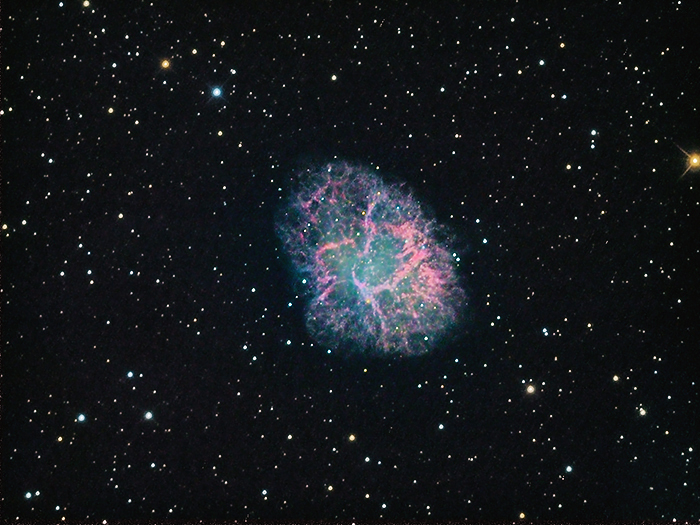11/8/2011. I like data. Piles and piles of it. You just can't have too much. A few nights of good seeing and long sub-exposures have produced three nice images. The Moon is bright, however, so I've been taking narrow-band hydrogen-alpha images and salting them with just a few minutes of RGB. When the Moon goes away, I'll collect more RGB to finish these images properly. In the meantime, in b/w and with thin color...

NGC 7635, The Bubble Nebula
9x1800s H-a, 1x300s RGB

NGC 7000 (detail)
9x1800s, 12s900s H-a

Messier 1
15x1800s Ha, 1x300s RGB
11/8/2011. People kept asking if was going to photograph asteroid 2005 yu55 as it swept by tonight closer than the Moon. I kept saying no, that I'd have to take the deepsky kit apart too far and reconfigure it for tracking something moving that fast — of course I was thinking of tracking the asteroid. It occured to me by and by that I could certainly lay up on a field ahead of it and let it run through the frame. Here you go:

Asteroid 2005 yu55
16x30s L,
1 RGB 300s
binned 2x2
That's a starfield in Pegasus imaged just before 9:30 PM EST. I made sixteen 30-second exposures of the field. The first streak appeared in the eleventh. I'd somehow expected the asteroid to take ten or twelve exposures to cross the field, but zoom! it ran from wall to wall in only four. The gaps are the delays while the camera read out the chip and downloaded a frame (keeping that gap short was the reason for binning the chip 2x2). Then I took color data of the starfield. There was a lot of moonlight in the sky, and the gradient was tough to deal with. The data are better than the picture, so far. I reprocessed everything the next morning, and it's about as good as it's going to get. It's not a beauty, but it is the close approach of a 400m asteroid -- maybe the smallest, closest solar system body I will ever image.
Except where noted, deep-sky photos are made with an SBIG ST2000XM CCD behind a 10-inch Astro-Tech Ritchey-Chretien carried on an Astro-Physics Mach1GTO. The CCD is equipped with Baader LRGB and 7nm H-a filters. A Meade DSI Pro monochrome camera looking through a modified Orion off-axis guider keeps the OTA pointed in the right direction. The imaging camera is controlled via Nebulosity 2; the guide camera is operated by PHD Guide 1.13, both by Stark Labs. The stock focuser on the AT10RC has been augmented with Robofocus 3.0.9 using adapters turned on the lathe downstairs. Maxim DL5.12 performs image calibration, alignment, and stacking; Photoshop CS4 and FocusMagic 3.0.2 take it from there. Gradient Xterminator by Russell Croman and Astronomy Tools by Noel Carboni see their share of work, too.
:: top ::